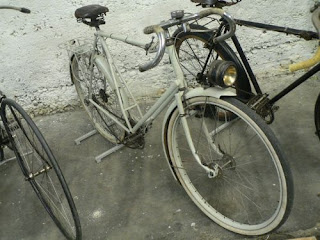The unusual summer rain in Olympia and job depression have left me hitting the books/interwebs more than riding. Doing some flipping around, I came across Monsieur Bachelier's Integral cyclo-camping bike.
It's an odd-ball and gimmicky design with the oval chainrings inside the frame [I'd be curious to see how the q-factor, tire clearance, chain line, and chainstay length are impacted by the necessitated spacing before actually considering it.] I was however excited by the location of the hub bearings being placed in the drop outs of the frame. In theory, this should be even more successful than a modern cassette hub at weight distribution for wheel loads. The Integral also features a simple lever that requires no additional tools to remove and service the bearings; handy for the at home or even on the road mechanic if done correctly. Obviously the need for proprietary parts keeps this from being immediately useful, but the potential is remarkable.
The down side I could possibly see is the reduced ease of wheel removal for this set up [at least compared to the traditional quick release hub.] I'd be curious to see this design combined with the bolt on thru-axle often seen on disc brake-equipped mountain bikes. It seems that adding bearings in such a fashion would not be a terrible leap, given enough room in the [not?] drop outs for the right sized bearing. Though this would mean that instead of the hub shell rotating around the axle, the axle would have to move inside the fork somehow while still being secure enough for the purposes of prevent wheel launching from disc brake force. Maybe some engineering student with access to some fancy CAD program is better suited to such theory...
Furthermore, it would seem that the extreme dishing that most modern 8+ speed rear wheels require seems to be a more pertinent weakness of wheel design these days than bearing location. Since most rear wheel fatigue comes from this compromise, perhaps the cassette is simply 'good enough' for the vast majority of circumstances? Though I guess 'good enough' shouldn't be in a aspiring constructeur's vocabulary, yeep...
Bachelier left cycling when World War II started, so it's hard to say how much of a sink or swim design this was. I'd be curious to see a technical trials test of this bicycle compared to traditional freewheel and cassette-equipped bikes of a similar grade.
Check out The Golden Age of Handbuilt Bicycles for more info and better pics.
It's an odd-ball and gimmicky design with the oval chainrings inside the frame [I'd be curious to see how the q-factor, tire clearance, chain line, and chainstay length are impacted by the necessitated spacing before actually considering it.] I was however excited by the location of the hub bearings being placed in the drop outs of the frame. In theory, this should be even more successful than a modern cassette hub at weight distribution for wheel loads. The Integral also features a simple lever that requires no additional tools to remove and service the bearings; handy for the at home or even on the road mechanic if done correctly. Obviously the need for proprietary parts keeps this from being immediately useful, but the potential is remarkable.
The down side I could possibly see is the reduced ease of wheel removal for this set up [at least compared to the traditional quick release hub.] I'd be curious to see this design combined with the bolt on thru-axle often seen on disc brake-equipped mountain bikes. It seems that adding bearings in such a fashion would not be a terrible leap, given enough room in the [not?] drop outs for the right sized bearing. Though this would mean that instead of the hub shell rotating around the axle, the axle would have to move inside the fork somehow while still being secure enough for the purposes of prevent wheel launching from disc brake force. Maybe some engineering student with access to some fancy CAD program is better suited to such theory...
Furthermore, it would seem that the extreme dishing that most modern 8+ speed rear wheels require seems to be a more pertinent weakness of wheel design these days than bearing location. Since most rear wheel fatigue comes from this compromise, perhaps the cassette is simply 'good enough' for the vast majority of circumstances? Though I guess 'good enough' shouldn't be in a aspiring constructeur's vocabulary, yeep...
Bachelier left cycling when World War II started, so it's hard to say how much of a sink or swim design this was. I'd be curious to see a technical trials test of this bicycle compared to traditional freewheel and cassette-equipped bikes of a similar grade.
Check out The Golden Age of Handbuilt Bicycles for more info and better pics.


I really, really like Integral hub disc. Until recently considered taboo amongst polite society, it is impossible to overestimate its impact on modern thought. The juxtapositioning of Integral hub disc with fundamental economic, social and political strategic conflict draws criticism from socialists, trapped by their infamous history. With the primary aim of demonstrating my considerable intellect I will now demonstrate the complexity of the many faceted issue that is Integral hub disc.
ReplyDelete